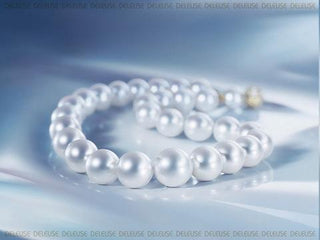The luster of any pearl, whether natural or cultured, depends on the thickness of the nacre. If the nacre is thin, the pearl will look chalky and dull; a pearl with thick nacre will appear ‘metallic’ and exhibit a reflection.
It is best to view pearls in natural light. Fine quality pearls exhibit iridescence. For example, a Tahitian grey pearl may have overtone hues of lavender, pink and olive greens—called ‘peacock’. A lustrous, even color, without blemishes and perfectly round is the most valuable.

The value will be diminished when a pearl is not completely smooth and has slight nicks, wrinkles, scratches, cracks, pits, dimples, bumps in the nacre, known as surface blemishes.
A perfectly round pearl is the most valuable of all. The Japanese Akoya form round pearls more often than any other type of oyster. There are many oval shaped pearls that may appear round; the price of a slightly oval pearl will be considerably less.
Many different shapes of pearls, depending on the type of oyster and the type of nucleation, are found all over the world. A Baroque shape refers to a pearl that is not round, but has an irregular shape with uneven surfaces. Examples of baroque shapes are called pear, rectangular, square, egg, button, wings and coin.

Tahitian pearls can be round, semi-round, drop, button, baroque and circle (rings around the pearl). South Sea pearls are round, semi round, circle and baroque. Freshwater pearls are mostly baroque and come in endless varieties of shapes, often flat as rather than spherical.
A blister pearl is a natural or cultured pearl that is attached to the surface of the shell, when they are removed from the shell they are flat on one side and covered in nacre on the top. Mabe pearls are a cultured blister pearl with a round top and tend to be very delicate. Seed pearls are very small natural pearls usually 2mm round. Keshi pearls are a byproduct of the oyster, a small pearl that can form in the muscle of the oyster in addition to the cultured pearl. They can be flat, oval, odd-shaped and usually has a poor luster quality.

When choosing a strand of pearls, the first thing to look for is matched size, color, roundness and luster. Pearls are traditionally strung on a special silk cord from Japan that are usually tied with a tiny knot in between each pearl to keep them separate and secure.
When pearls are worn over the years the thread will stretch, if the pearl slides on the thread, it is an indication that it is time to have the pearls taken apart, cleaned and restrung. A 16” strand is called a choker; 18” strand a princess; 20” a matinee and 32” an opera. Any strand longer than opera is called a rope of pearls.
Pearls are a delicate gem that can easily be damaged or destroyed with perfumes, hair sprays and oils from skin. The nacre, or surface of the pearl, will dissolve from acids.
Pearls should never be worn in water such as hot tubs, swimming pools or showers. Extreme heat can crack the nacre, if left in the sun or by a heater.
Pearls need to be cleaned with a soft, damp cloth, without the use of any detergents or cleaners. Never use any type of abrasive cleaners or abrasive materials or the pearl surface. Do not put pearls in ultrasonic cleaners or commercial jewelry cleaners.
A damaged pearl can never be repaired because the nacre cannot be replaced. Pearls should be stored in a soft pouch or pearl folder. Safekeeping and treatment of pearls will ensure that pearls can last for generations.
Janet Deleuse
For more information call us: 415-459-3739



